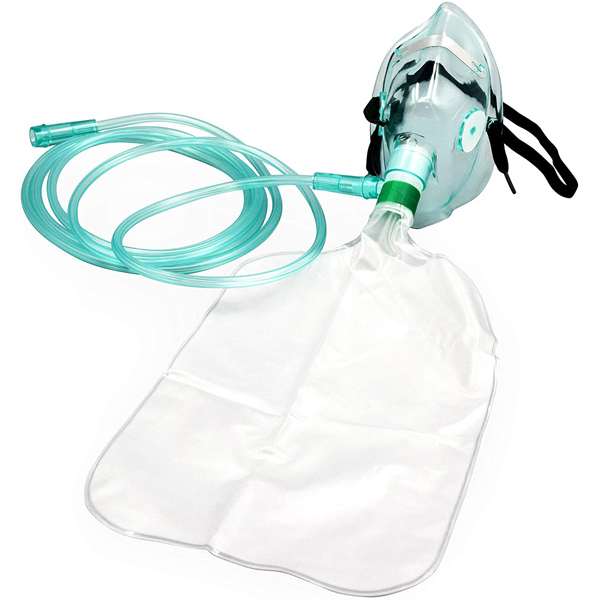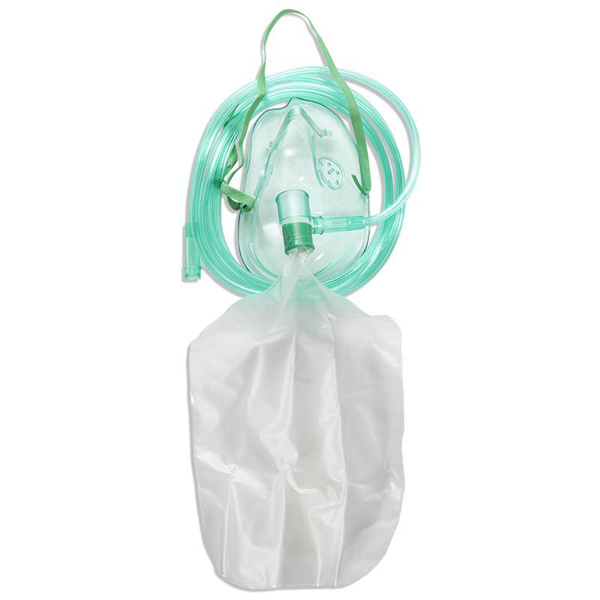What is a non-rebreather mask?
A non-rebreather mask is an oxygen mask that delivers high concentrations of oxygen. It's for when a person needs oxygen quickly in emergencies like injury, smoke inhalation or carbon monoxide poisoning. It's not available to use at home.
A non-rebreather mask is a type of oxygen mask that gives a person a lot of oxygen, typically in an emergency. There's a risk of suffocation since it doesn't allow you to breathe in any outside or room air. For this reason, non-rebreather masks are typically for hospital or emergency department use only. If you have difficulty breathing on a day-to-day basis, talk to your healthcare provider about other forms of oxygen therapy.
A non-rebreather mask (NRM) is a device that gives you oxygen, usually in an emergency. It's a face mask that fits over your mouth and nose. An elastic band stretches around your head to keep the mask on. The mask connects to a small bag filled with oxygen (reservoir bag), and the bag is attached to an oxygen tank. It provides a high concentration of oxygen quickly, typically in a hospital or emergency room, or in an ambulance during transportation to a hospital.
The main feature of a non-rebreather mask is that it has several one-way valves. Simply put, a one-way valve ensures air only comes in or out one way. The valves prevent you from "rebreathing" any exhaled air or room air. You're only inhaling oxygen directly from the reservoir bag and oxygen tank, with no outside air diluting the oxygen. While this gets you more oxygen faster, it's also a risk. When the oxygen tank empties, there's no other source of air, meaning you could suffocate in the mask. .
Most studies report that a non-rebreather mask allows a person to get 60% to 90% FIO2, which stands for fraction of inspired oxygen (oxygen in the air). This is a high and concentrated amount of oxygen. For reference, the FIO2 of a standard face mask (also called a rebreather mask) is about 40% to 60%, and the FIO2 in the air around you is about 21%.
When do you use a nasal cannula vs non-rebreather mask?
A nasal cannula is often the best choice for at-home oxygen therapy. As the name suggests, it delivers oxygen through two small prongs that sit in your nostrils. People with respiratory conditions that cause difficulty breathing use a nasal cannula. A non-breather mask isn't for home use. Its main use is for emergency situations when a person needs oxygen quickly. It delivers much more oxygen than a nasal cannula.
Non-rebreather masks are usually for emergency use when a person has low blood oxygen levels, but can breathe on their own. Some examples of emergency situations would include:
- Smoke inhalation.
- Carbon monoxide poisoning.
- Trauma or other serious injury to your lungs.
- Cluster headaches.
- Severe, chronic airway disorders such as COPD or cystic fibrosis.
What is the difference between a partial rebreather and a non-rebreather mask?
The main difference between the two masks is in how much recycled air you rebreathe. A partial rebreather mask has two-way valves instead of one-way valves. This means you rebreathe a small amount of outside air. With a non-rebreather mask, the one-way valve doesn't allow you to breathe in any outside air. Because of this, a partial rebreather mask doesn't have the same risk of suffocation as a non-rebreather mask. The FIO2 of a partial rebreather mask is slightly less than a non-rebreather mask.
When should I call my healthcare provider?
If you have difficulty breathing and have any of the following symptoms, contact your provider right away:
- Pale or blue lips.
- Breathing rapidly or laboring to breathe.
- Nasal flaring (your nostrils get wide when you breathe in).
- Wheezing, grunting or other noisy breathing.
A non-rebreather mask isn't available to use at home or in situations where you need a little extra help breathing. But there are oxygen therapies for use in these cases. A non-rebreather mask is only for emergency situations where a person needs a lot of oxygen quickly.
Discuss any breathing difficulties you're having with your healthcare provider so they can recommend an oxygen treatment to help you.









